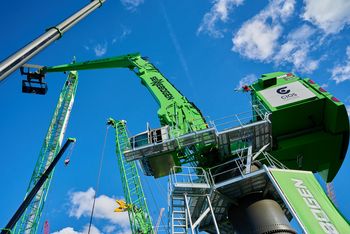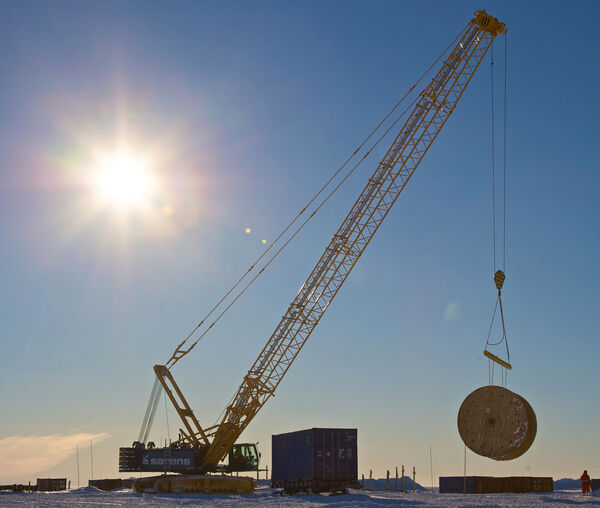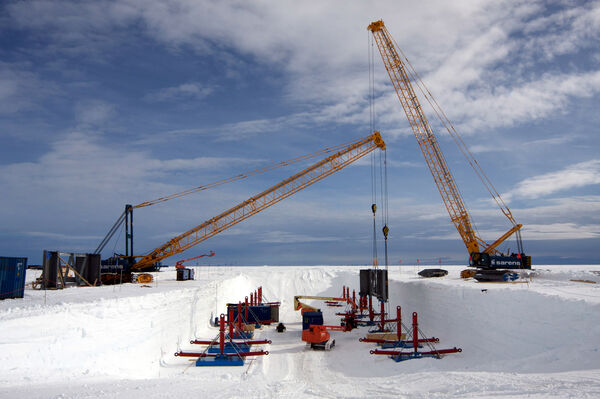Two SENNEBOGEN 3300 Star-Lifter in the everlasting ice of Antarctica
On November 17, 2007, everything was ready. After intense preparation and planning, the Danish freighter "Naja Arctica" left Bremerhaven and started its journey to the Antarctic Ocean. On board was the new German Antarctic station Neumayer III (disassembled into its individual parts) and all the machines required for the installation. A total of 3,500 tons of material were transported to one of the most unusual construction sites in the world. This also included two SENNEBOGEN 3300 Star-Lifter crawler cranes.
Both SENNEBOGEN 3300 crawler cranes have been leased from SARENS, for the long-term, by the Joint Venture Neumayer III (KAEFER GmbH and J.H.K. Anlagenbau und Service GmbH) who is constructing and erecting the new polar station for the Alfred Wegener Institute for Polar and Marine Research (AWI). SARENS is a well-known specialist in solutions for the most difficult tasks. That is why the Institute relied on the experience and expertise of SARENS. Due to the extreme operating conditions in Antarctica, SARENS equipped both SENNEBOGEN machines with a low-temperature package. «Neumayer III» is the third German research station in Antarctica. With a service life of up to 30 years, the Neumayer III is designed for long-term operation, contrary to its two predecessors. While the first two stations had an issue with slow sinking into the ice and snow, the new station will be held above the growing ice and snow layers with the help of hydraulic supports. The design concept of the Neumayer Station III is a patented development by the Alfred Wegener Institute and combines research, operation, and living on one platform above the snow surface. If everything goes according to plan and the weather cooperates, the first researchers will move into the two-story platform, which is 30 meters high with 4,473 m2 of space, in February 2009.
The first huge challenge for the 40-person construction team was the transport of material and machines to the construction site, which is approx. 20 km away from the shore. Shortly after their arrival, the first construction phase was expedited greatly. Due to the extremely short timeframe, one of the SENNEBOGEN 3300 crawler cranes was working around the clock. The second machine was used during the day shift. Storms and cold temperatures continuously pushed the team to its limits.
Three experienced SARENS employees are responsible for the smooth operation of the machines, and they are extremely satisfied with the equipment. Both SENNEBOGEN 3300 Star-Lifter have proven to be very reliable and powerful machines without any downtimes. Lifting operations of all kinds were executed in a safe and precise manner. Both SENNEBOGEN 3300 machines met every challenge, including containers, steel beams, and heavy materials. With a lifting capacity of 125 tons, the machines are well-equipped for all the different tasks at the site. 900 mm shoes give the machines a large amount of stability and traction in snow and ice. The robust construction and absence of unnecessary over-engineering as well as the excellent accessibility of all service and maintenance points make these machines very suitable for this environment. Temperatures of -10 to -40 degrees and wind speeds of 25 m/sec. illustrate the extreme conditions for humans and machines in Antarctica.
With the completion of the garage in mid-March 2008, the first stage of the construction ended. This was an important step in making the station winter-proof and in protecting the ongoing construction against storms and snowdrifts. The booms were removed on both SENNEBOGEN 3300 machines, the cabins were covered with wood, and all openings were sealed. The construction team will come back in November 2008 to complete the research station and is already anxious to see what condition the construction site will be in.
Caption:
The two SENNEBOGEN 3300 Star-Lifters work with great reliability even under extreme conditions in the Antarctica.
(images: realnature.tv)







